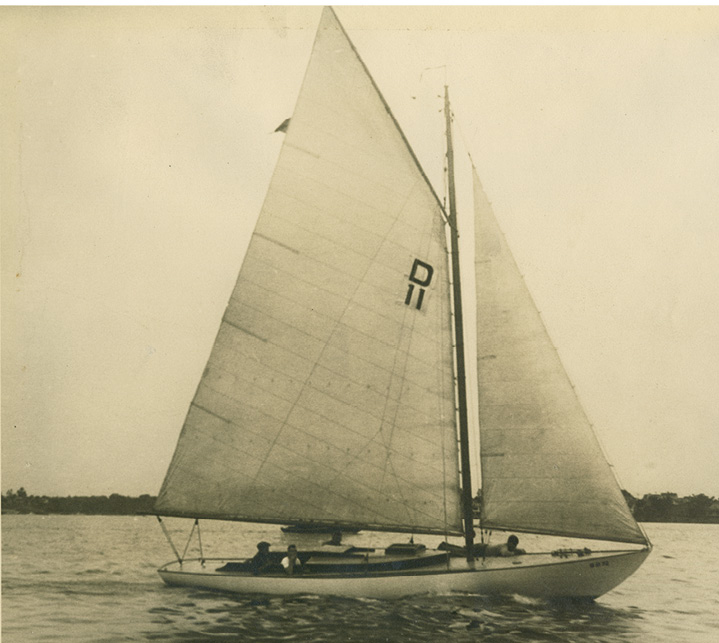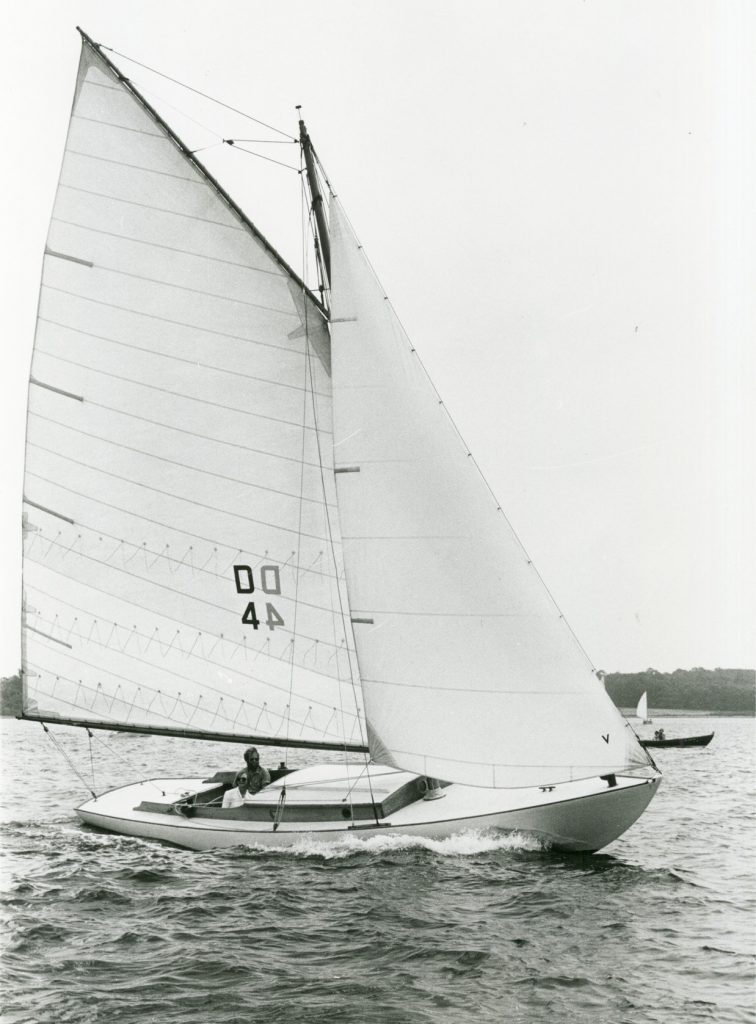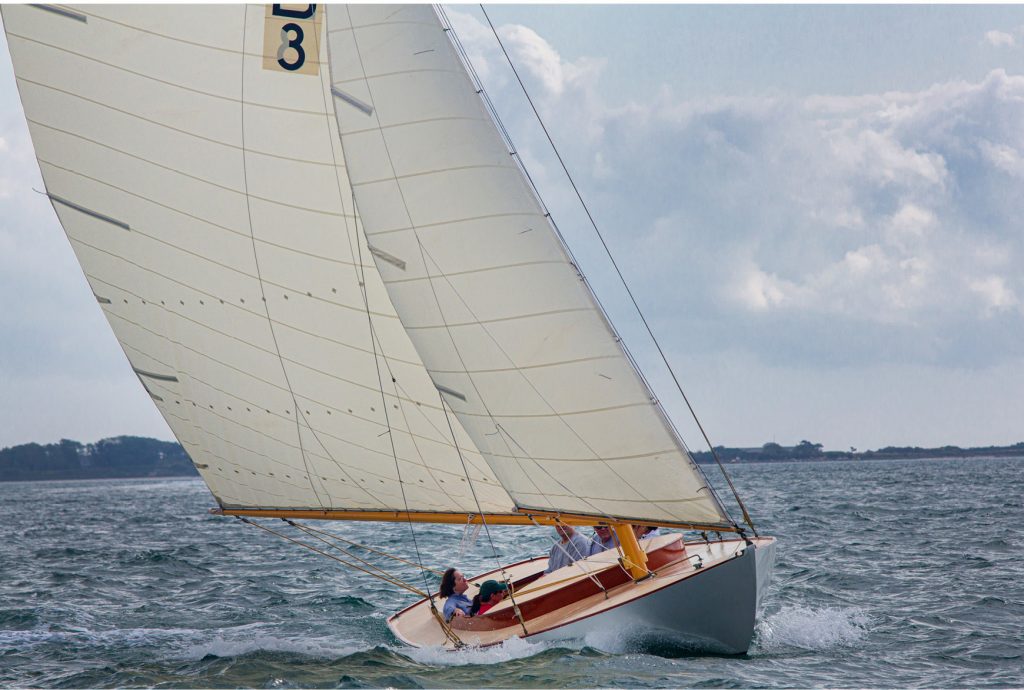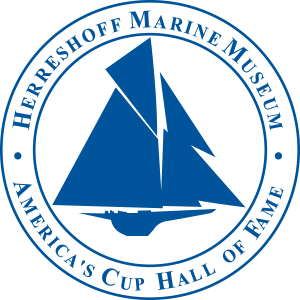The Beverly Yacht Club and Buzzards Bay 1914
By David Cheever, reprinted from an article in the Herreshoff Marine Museum Chronicle No. 23 – 1994.
Editor’s note: We’re changing tacks with this month’s Herreshoff Jubilee article. Our friends at the Herreshoff Marine Museum & America’s Cup Hall of Fame in Bristol, Rhode Island are celebrating their Golden Jubilee year – the 50th anniversary of the museum’s founding, and WindCheck is honored to be the official Jubilee Media Partner.
The Herreshoff Marine Museum is located on the grounds of the former Herreshoff Manufacturing Company where more than 2,000 yachts were built over more than six decades, including eight consecutive America’s Cup defenses between 1893 and 1934. The Herreshoff Jubilee encompasses a yearlong calendar of fresh content and compelling events (both virtual and in-person, regulations permitting). To learn more, log onto herreshoff.org.

Bagatelle, owned by F.L. and G.B. Dabney, circa 1915 © herreshoff.org
This brief account of an outstanding effort which never fully flowered is peppered with “ifs” and “might have beens.” It is offered as a matter of historical record. Herreshoff was already the outstanding designer-builder name to conjure with when our story starts in 1914. The Beverly Yacht Club started north of Boston close by Marblehead in 1872, featuring small boat racing. Its move to Buzzards Bay was clearly motivated by the fine sou’westers most summer afternoons produced. The calm and fickle breezes in Massachusetts Bay could not compare to the robust breezes south of the Cape.
By 1914 where the story begins, the Beverly Yacht Club had been through various phases which included catboats, knockabouts and sloops before waking up to the fact that the greatest good for the greatest number could be achieved by several one-design classes which thus avoided the financial pitfalls of overdesigning and overbuilding. After all, it was a rare boat that had a first-class racing record after more than four or five years of stiff competition in an open class. The famous Herreshoff 15-footer started the ball rolling in 1899 with credits to Herreshoff genius plus helpful arranging from Emmons, Parkinson and Stackpole.
Tradition always had it that the 15-footers had a little of the Columbia (1899/1901 America’s Cup defender) in their lines and the same applied to the 18-footers. Both classes were characterized by long ends which gave them speed and bearing when heeled over in a thrash to windward. To be truthful this characteristic was not an unmixed blessing because both classes took a punishing beating in the stiff chop involved in a “stiff sou’wester.” Crews were limited to three in these two classes. By 1914 it became evident that long ended small yachts must have changes made because of drooping ends, or hogging, and a tendency to leak when unduly punished.
Captain Nat had the answer in his plans. It involved short ends, more freeboard, plus moderate draft for Buzzards Bay conditions. Robert Emmons had been looking for the ideal adolescent adapted small racing boat; the result was the tremendously successful 12-footers which stand as a class alone after 80 years! Its success was in the sou’wester chop, the prodding by Emmons, and the genius that was Herreshoff.
The stage was set for an enlarged one-design class which would fill the needs of mature crews. The resulting class, known as the 25’ Herreshoff Special Class, measured length overall: 32 feet, waterline: 25 feet, beam: 8 feet 6 inches, draft: 3 feet without centerboard, outside fixed ballast 3,000 pounds, sail area not over 550 square feet. It is worth taking a look for a moment at the 18-footer previously referred to. They looked for all the world like an enlarged 15-footer but were 29 feet overall, 8 feet 1 inch beam, draft 3 feet without centerboard, outside fixed ballast 2,000 pounds, 470 square feet sail area. It will be quickly noted that the 25-footer, with sweet forward lines coupled with short forward overhang, made for a much more seaworthy vessel than the long overhang of former one-design classes.
The Herreshoff Special Class included Vitessa owned by Galen Stone, Whitecap owned by William Amory, Mink owned by Howard Stockton, Jr., Bagatelle owned by F.L. and G.B. Dabney, and Tarantula, owned by W.H. Langshaw. These boats raced for four seasons. The seasonal championships are as follows: 1914 Mink, 1915 Bagatelle, 1916 Mink, 1917 to 1920 no racing, and 1920 Mink.
The 1914 season was distinguished by a unique incident. The date in question was August 1, 1914 and the facts were related to me by fine old Robert Stone who came to be a close friend in Dedham in the 1970s. On the day in question the judges for the race were D.P. Robinson and Howard Stockton, Jr. Their report reads “wind – whole sail southwest, changing to a very heavy N.W. squall; then whole sail southwest.”

Captain Nat Herreshoff designed the Buzzards Bay 25 to thrive in the bay’s robust sou’westers. Aria is pictured here. © herreshoff.org
There were four classes racing in different directions in the upper reaches of the Bay. In the 25’ Herreshoff Special Class were Mink, Bagatelle, Vitessa and Whitecap. These four were closely bunched and were having their hands full for they were carrying whole sail in a reef breeze. There were three in Vitessa’s crew. Two of the men were members of the Stone family and the third was a professional boatman who worked for the family. Bob Stone was about 14 at the time and was left ashore because three strong men were needed. With no warning the lowering sky became black. The wind shifted almost 180 degrees and all hell broke loose. Strangely enough the Twenty Fives found themselves in the middle of a twister. The rain came in blinding sheets and sails were doused on the run. There was no time to secure the crotch, the boom cranked down over the cuddy and the gaff followed it. The crewman, knowing that there was no time to pass stops, jumped up on the gaff and boom with mainsail between and lying on his stomach wrapped his arms and legs around the mainsail trying to hold it down. Bob Stone was told that owing to the twister action the two spars were blown upwards on the mast leaving the struggling man in a perilous position. The whole episode took less time than it takes to write about it. The rest of the crew got the spars on deck again and the crewman was unhurt.
Vitessa was half full of water and it took some time to clear her, for the Twenty Fives were not made with self-bailing cockpits. This was in the interest of keeping the crew weight down low and on the assumption that the new design was so stiff that the vessel wouldn’t ship water and it wasn’t assumed that she would be caught in a miniature hurricane! Right here it should be noted that the twister was narrow and localized. The other classes were shaken up but unharmed and only one other boat withdrew. This mishap could not have come at a worse time for the fledging Twenty Fives: the middle of the first season of a new one-design with everyone watching from the porch of the brand new clubhouse. It involved people who were skilled, substantial members and whose judgment was looked up to.
Herreshoff never built another boat for this particular class and the pendulum started to swing to self-bailing cockpits. Not completely though because the noble S Class which appeared in 1919 was a deep cockpit design and one which has given great satisfaction in spite of the curved mast which made reefing a complicated safety measure. The old Twenty Fives were going their unheralded way and even today four of the five are in existence and in good hands. The only missing boat is Tarantula, which disappeared from the Beverly Yacht Club book in the 1920s. Many of us would like to find her and hopefully in original condition! If it weren’t for the “ifs” and “might have beens” the class would be appealing today. Daysailing is becoming more and more popular again while short cruises are a complicated procedure.
Editor’s note: David Cheever’s article is accompanied by this important collection update in The Chronicle.
In 1992, Paul Bates of Noank, CT donated his Buzzards Bay 25, Aria (ex-Whitecap – HMCo. #738), to the museum. Paul had owned Aria for 22 years and during this time, lovingly maintained and sailed her. He participated in such events as the Herreshoff Rendezvous and Classic Yacht Regattas. She was, however, beginning to show her 80 years and needed a fair amount of structural rebuilding.

A small boat with a big personality: Mink shows off her lovely lines at the HMM Regatta. © Caryn B. Davis Photography
Wishing to preserve as much of the original construction as possible for future generations, Paul donated her to the museum for display and research. Shortly thereafter, the museum commissioned the restoration shop of McClave, Philbrick & Giblin to remove old restoration components and return her to an original 1914 configuration. The final element was to give her a fresh coat of paint in the traditional Herreshoff color scheme of green bottom, white topsides and buff deck. In June, 1993 Aria returned to Bristol looking as good as she did on launching day in 1914. Within the museum’s Hall of Boats, Aria continues to provide inspiration to other Buzzards Bay 25 owners and all Herreshoff admirers. The museum is grateful to Paul Bates for his devotion to a special boat and desire to preserve a unique example of our yachting heritage.
The historic significance of owning, preserving and sailing one of the very few Buzzards Bay 25s is existence is not lost on a Herreshoff devotee, including the owner of Mink: “To be involved with Mink means a great deal to me. As you know, we have done our best to preserve and restore the boat to exactly as she was when new. Manila lines are coarser than a modern equivalent and stretch more but are easier to grip and, once stretched, glide through the blocks with ease. And cotton sails need teasing into shape to get the most from them, so a skipper’s understanding of the sail shape improves with use. When that big mainsail is properly set and the boat finds her groove, it takes only a light hand on what is, in fact, a little tiller to really get along and that sticks with you long after you put the boat back on the mooring.”
“For me Mink is the perfect boat; small enough to allow for easy use with just another person for crew but large enough to carry a crowd when you want one; simple enough to be (relatively) easy to keep in proper fettle but complex enough to offer infinite details to engage the interested; easy to sail when you want her to be and exciting to sail when you are racing and, in my opinion, about as nice looking on the water as anything you are likely to come by. She is a small boat with a big personality.”
“We’ve had plenty of exciting races in Mink, but one that comes to mind happened a few years ago in Newport. On the Saturday we lost the wind and were stuck in the channel as a freighter was coming through and with nothing more than two paddles to get out of the way it was exciting for a while. I can tell you now those freighters have a mighty powerful bow wave when you’re close to them. On Sunday the winds were terribly strong – I think a hurricane was coming up the coast – but we put in a reef and off we went. It was hard to keep the boat down and, at times, we had so much water coming over the coaming that eventually it was above the sole when heeled over but Mink came through and nothing broke. Quite something when you think we’ve done nothing to strengthen her beyond what Capt. Nat specified.” ■





